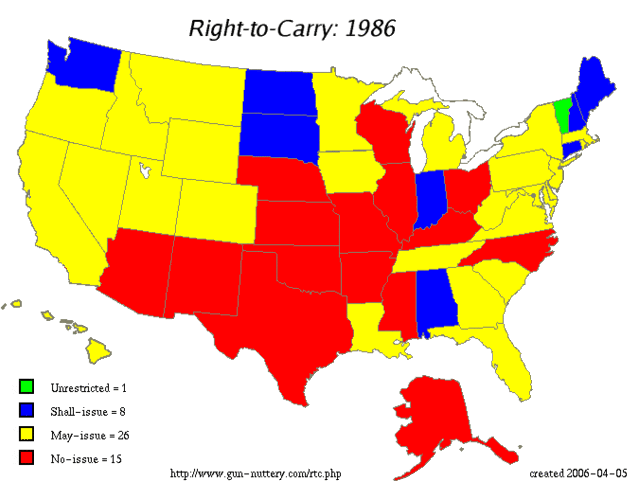Missourian
Diamond Member
Crime & Criminal Justice
More Guns, Less Crime (Again) in 2008
Over the last two decades, many “gun control” laws have been eliminated or made less restrictive at the federal, state, and local levels.
Numbers of privately-owned guns and Right-to-Carry states have risen to all-time highs.
Every step of the way, “gun control” groups have predicted violent crime would increase.
Instead, the nation’s violent crime rate has been declining since 1991, and in 2008 fell to a 35-year low.
In the same period, the nation’s murder rate fell to a 43-year low.
Less “Gun Control”: The Brady Act’s handgun waiting period expired in 1998, in favor of the NRA-supported National Instant Check System. Some states thereafter eliminated waiting periods or purchase permit requirements.
The federal “assault weapon” ban expired in 2004.
Since 1987, 30 states have eliminated prohibitory or restrictive carry laws, in favor of Right-to-Carry (RTC) laws; there are now 40 RTC states, an all-time high.
All states have hunter protection laws, 48 have range protection laws, 48 prohibit local jurisdictions from imposing gun laws more restrictive than state law, 44 protect the right to arms in their constitutions, and Congress and 33 states have prohibited frivolous lawsuits against the firearm industry.1
Studies by or for Congress, the Congressional Research Service, the Library of Congress, the National Institute of Justice, the National Academy of Sciences, and the Centers for Disease Control and Prevention have found no evidence that “gun control” reduces crime.2
More Guns: There are 250+ million privately-owned firearms in the United States.3
The number of guns typically rises by about 4.5 million every year,4 though between 2007-2008, firearm transactions cleared by the National Criminal Instant Background Check rose 14 percent.5
Less Violent Crime: Since 1991, the nation’s violent crime rate has decreased 40 percent (murder, 45 percent; rape, 31 percent; robbery, 47 percent; and aggravated assault, 37 percent. From 2007-2008, the violent crime rate decreased 3 percent (murder, 5 percent; rape, 2 percent; robbery, 2 percent; and aggravated assault, 3 percent.)
States with Right-to-Carry laws have lower violent crime rates, on average, compared to the rest of the country: total violent crime by 31 percent, murder, 39 percent; robbery, 55 percent; and aggravated assault, 19 percent.
States that have the most restrictive gun control laws tend to have the highest ratios of robberies (confrontational violent crimes) to non-confrontational property crimes. 6
For footnotes and references visit NRA-ILA :: More Guns, Less Crime (Again) in 2008
More Guns, Less Crime (Again) in 2008
Gun Ownership at All-Time High, New FBI Report Shows
Violent Crime at a 35-Year Low, Murder at a 43-Year Low
Over the last two decades, many “gun control” laws have been eliminated or made less restrictive at the federal, state, and local levels.
Numbers of privately-owned guns and Right-to-Carry states have risen to all-time highs.
Every step of the way, “gun control” groups have predicted violent crime would increase.
Instead, the nation’s violent crime rate has been declining since 1991, and in 2008 fell to a 35-year low.
In the same period, the nation’s murder rate fell to a 43-year low.
Less “Gun Control”: The Brady Act’s handgun waiting period expired in 1998, in favor of the NRA-supported National Instant Check System. Some states thereafter eliminated waiting periods or purchase permit requirements.
The federal “assault weapon” ban expired in 2004.
Since 1987, 30 states have eliminated prohibitory or restrictive carry laws, in favor of Right-to-Carry (RTC) laws; there are now 40 RTC states, an all-time high.
All states have hunter protection laws, 48 have range protection laws, 48 prohibit local jurisdictions from imposing gun laws more restrictive than state law, 44 protect the right to arms in their constitutions, and Congress and 33 states have prohibited frivolous lawsuits against the firearm industry.1
Studies by or for Congress, the Congressional Research Service, the Library of Congress, the National Institute of Justice, the National Academy of Sciences, and the Centers for Disease Control and Prevention have found no evidence that “gun control” reduces crime.2
More Guns: There are 250+ million privately-owned firearms in the United States.3
The number of guns typically rises by about 4.5 million every year,4 though between 2007-2008, firearm transactions cleared by the National Criminal Instant Background Check rose 14 percent.5
Less Violent Crime: Since 1991, the nation’s violent crime rate has decreased 40 percent (murder, 45 percent; rape, 31 percent; robbery, 47 percent; and aggravated assault, 37 percent. From 2007-2008, the violent crime rate decreased 3 percent (murder, 5 percent; rape, 2 percent; robbery, 2 percent; and aggravated assault, 3 percent.)
States with Right-to-Carry laws have lower violent crime rates, on average, compared to the rest of the country: total violent crime by 31 percent, murder, 39 percent; robbery, 55 percent; and aggravated assault, 19 percent.
States that have the most restrictive gun control laws tend to have the highest ratios of robberies (confrontational violent crimes) to non-confrontational property crimes. 6
For footnotes and references visit NRA-ILA :: More Guns, Less Crime (Again) in 2008
Copyright 2009, National Rifle Association of America, Institute for Legislative Action.
This may be reproduced. It may not be reproduced for commercial purposes.
This may be reproduced. It may not be reproduced for commercial purposes.
Last edited:


